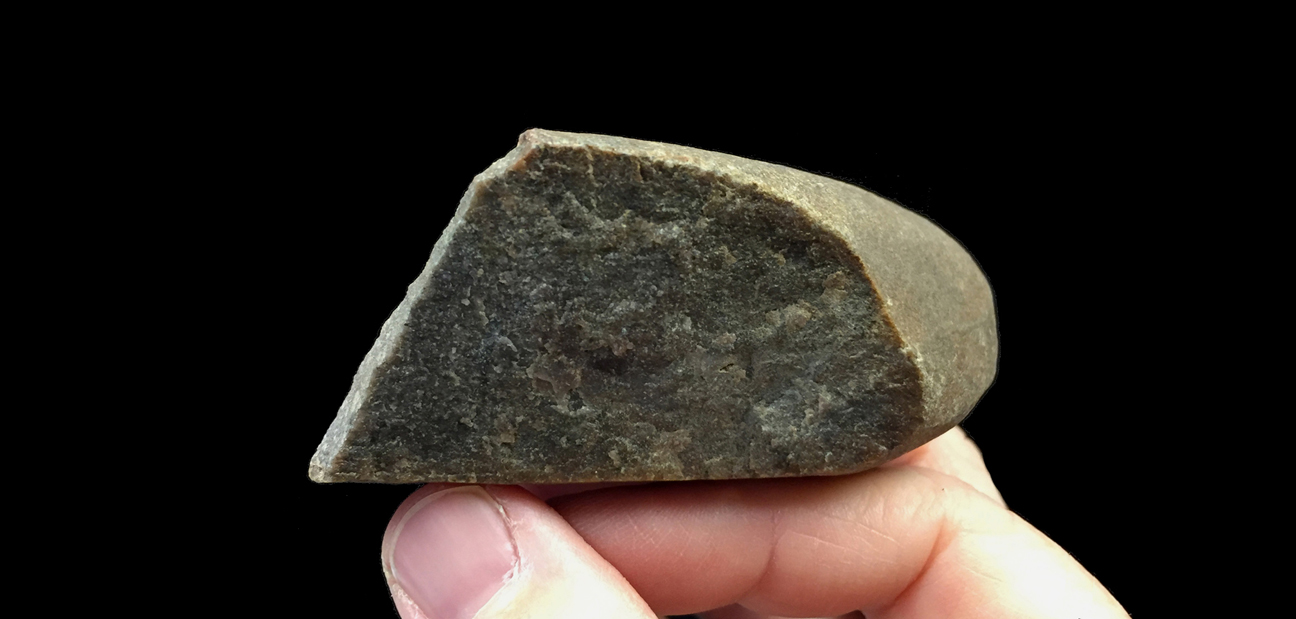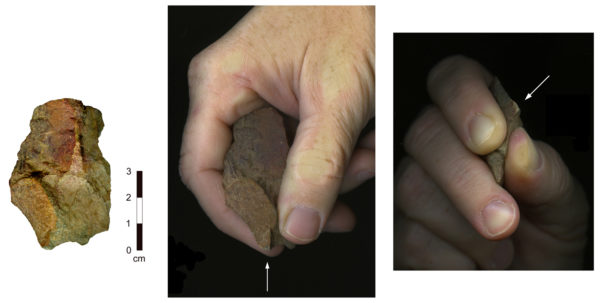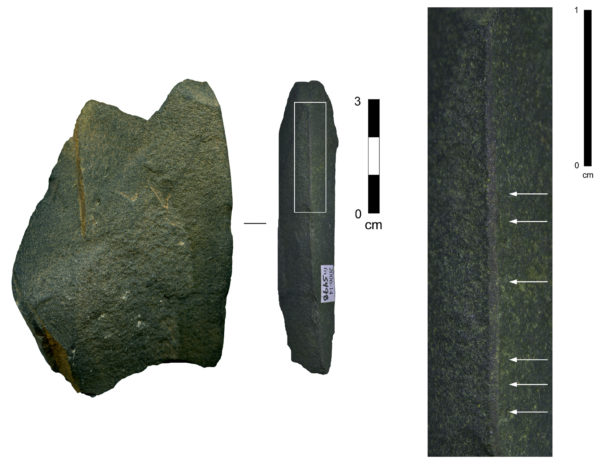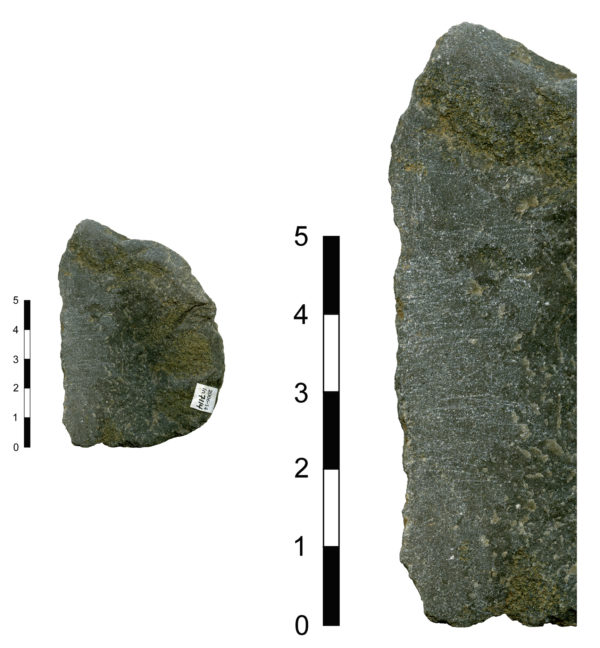
Hohokam Flake Tools and the Eye of the Beholder
R. J. Sliva, Desert’s senior flaked stone analyst, has thoughts about an often-maligned set of stone artifacts.
Think about the last time you used a metal tool. Maybe you sliced up a peach to make your yogurt palatable or fired up a Dremel to carve some stone beads for your Etsy shop. Now think about performing those tasks without steel or iron. The people who lived in southern Arizona before the first Spaniards trekked through in 1694 did not have access to metal tools. If they needed a sharp edge, their best option was to pick up a rock and hit it with another rock to break off a flake of stone. If the flake they created was suitable for the task at hand, they could use it as is. If not, they struck another and another until they had what they needed, or shaped the flake into a desired tool form by striking additional smaller flakes from its edges.
The practice of striking flakes from a stone core and shaping either the flakes or the core into finished tools through further flaking is referred to as knapping, and the sets of knapping behaviors, techniques, and resulting artifacts hominids have produced over the past million years are collectively referred to as flaked stone technology. It’s a fascinating field of study because regardless of how old the artifacts are or where on the planet they were made, the physics of knapping have been constant since day one. Force is applied to one side of the stone, travels through the stone, and detaches a piece of the stone when it exits another side. Crack.
The poster child of flaked stone technology is the beautifully pressure-flaked projectile point, formed not by striking but by pushing a pointed flaker against a thin stone edge until fine flakes pop off. It’s beautiful, and it’s a good day in the lab when you get to see one.

Outstanding examples of projectile points from southern Arizona. The leftmost four are from the Early Agricultural period (2100 BC-AD 50) in the Tucson Basin; the rightmost two are Sedentary period Hohokam (A.D.950-1150), from the La Villa site in Phoenix and the Gatlin site near Gila Bend.
That doesn’t happen so often.
Most of the flaked stone artifacts recovered at archaeological sites in southern Arizona aren’t beautiful points, but instead flakes. Hundreds, thousands, tens of thousands of flakes that were produced by people in the course of their daily lives as they reduced cores and occasionally fashioned them into tools. They are not particularly aesthetically intriguing at first glance. Hohokam toolkits in particular, with their emphasis on unmodified flakes and simple scraping and cutting flake tools, have often been regarded as simplistic collections far removed from the technological sophistication of earlier hunter-gatherers. In fact, Emil Haury—the legendary University of Arizona researcher who was one of the pioneers of Hohokam archaeology—described the situation like this: “For their bizarre arrowhead shapes, the Hohokam have long been noted; but at the other end of the spectrum are a number of practical though clumsily chipped tool classes which do little for the imagination.”

A large flake tool from a Hohokam site under the modern Pima Animal Care Center. Perhaps not as immediately compelling as the points.
However, upon closer examination, many of these seemingly simple flake tools exhibit evidence of intensive and repeated use and maintenance. Today we’ll look at some examples from Honey Bee Village, a large Hohokam settlement in Oro Valley that was excavated by Desert Archaeology in 2006-2007 (click on images to enlarge). The wear traces on some of the pieces are easy to see as soon as they are removed from the artifact bags. In other cases, I noticed them only after picking flakes up and flipping them around in my hand a few times until they snapped into place, as if by magic, suddenly fitting my grip, and then examining the part of the edge exposed beyond the ends of my fingers. Magnified images of the working edges of these pieces then revealed evidence for use that might otherwise escape a casual view.

Unmodified flake tool, Honey Bee Village, Early Rincon-Middle Rincon 1 phases (A.D. 950-1040). This piece initially appeared to be completely nondescript (left). A closer look revealed abrasion on the incipiently (naturally) pointed lower left edge. When the flake is held with the abraded point down, the fit matches the right hand (center). The arrow the indicates location of the wear. A view from below the working edge (right) shows how the incipient ridges on the dorsal surface of the flake serve as naturally occurring slots that the fingers on the right hand fit into, providing a secure and comfortable grip. The arrow indicates the working surface, which is smooth and flattened. This piece was likely used for graving or incising a hard material such as dried bone, antler, or soft stone.
Use-wear traces include rounded and smoothed edges on flakes that are otherwise coarse-grained, staining, and even scratches and striations that show the direction of use. Together, they indicate that the flakes were chosen due to some innate attributes that made them well-suited to the task at hand—despite their unremarkable appearance—and then were retained as favorite tools. Some of the heavy use bevels are even cut with fine, regular flaking, evidence that the user resharpened the tool when the wear dulled its edge.

Utilized flake, Honey Bee Village, Rillito phase (A.D. 850-950). This flake is representative of the Honey Bee residents’ emphasis on locally available granular, indurated stone. The flat terminal edge of this large flake has been flattened into a bevel through heavy use. The box indicates area of detail shown at right: very heavy planing or scraping wear with perpendicular striations (the deepest striations are indicated by the white arrows) on a wide use bevel.

Utilized flake, Honey Bee Village, Early Rincon phase (A.D. 950-1000). This large, thin flake (left) comfortably fits the right hand. A wide abraded surface is visible adjacent to the left edge. Magnified detail (right) shows heavy shaving or planing wear. This piece is particularly interesting for its evidence of multiple uses. The perpendicular striations that extend back from the edge overlie the longitudinal striations running parallel to the edge, indicating that the flake was used first for cutting or sawing, held upright and at a right angle to the material being worked, and subsequently for planing, with the flake held nearly flat against the worked material and pushed away from the user.
Although these flake tools were not designed in the classic sense, they certainly reflect consistent standards of edge shape, durability, maintainability, and hand fit on the part of their users, and provide an interesting perspective on the thought processes behind tool selection. Some pieces fit one hand better than the other, with about ten percent of the tools that seem to favor one hand reflecting left-handed use—a proportion that reflects modern populations. Then, as now, when people found a tool that performed effectively and was comfortable to hold, they kept using it.
Few experiences provide such a sense of connection with the past as picking up an ancient tool, flipping and turning it over and over in your fingers, and suddenly finding that it fits into your hand perfectly, and that the darkened smudge marks on its surface match where your fingertips fall. The Hohokam knappers who made these flake tools did not invest the same amount of time and energy into their design as they did into elaborate projectile points—but they were still cognizant of tool functionality and made careful choices. A wealth of information about decisions related to task performance are there in the piles of nondescript flakes. We only need to take a closer look.


